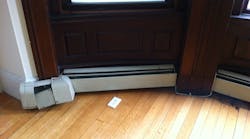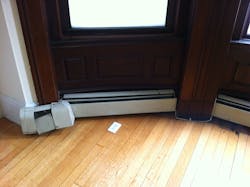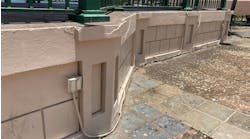Hint: This installation floors me
See the answer below.
Close, but not quite right. I’m guessing the installer chose to put this floor receptacle in place to fulfill the requirements for wall receptacles as specified in Sec. 210.52(A)(2). Receptacle outlets installed in or on the floor are permitted in accordance with Sec. 210.52(A)(3) where the receptacle is located within 18 in. of the wall. But that is not the problem here. The problem is the type of box used for this installation. The installer used an “old work” box that would typically be cut into an existing sheetrock wall and held in place with “Madison bars” or “battleships” or some other nickname used to describe “box positioning devices.” Section 314.27(B) requires boxes specifically listed for the application to be used for receptacles located in the floor. The exception for that section allows the AHJ some discretion to allow other boxes to be used in the elevated floors of show windows. However, the exception is not applicable to this dwelling unit installation.





